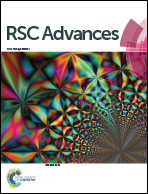Using poly(3,4-ethylenedioxythiophene) containing a carbamate linker as a platform to develop electrodeposited surfaces with tunable wettability and adhesion
Abstract
To control the wettability of polymer interfaces with water without using perfluorinated chains, the 3,4-ethylenedioxythiophene (EDOT) monomer and its derivatives have been good candidates for surfaces formed by electrodeposition. In this work, a series of original EDOT-based monomers were studied. A carbamate linker was used to introduce alkyl and aromatic substituents onto the EDOT-monomer, and the side groups were found to significantly influence the resulting surface structuration and wettability. As the chain length of the alkyl substituent increases, rougher, more hydrophobic surfaces form. With significantly long alkyl side groups (![[double bond splayed left]](https://www.rsc.org/images/entities/char_e009.gif) C6), superhydrophobic properties including water contact angles (θwater) up to 158° were observed despite the intrinsic hydrophilicity of the polymers. In general the monomers with aromatic substituents formed smoother surfaces. Oleophobicity was tested using diiodomethane, and it was found that the wetting state varied with the side group: longer alkyl (
C6), superhydrophobic properties including water contact angles (θwater) up to 158° were observed despite the intrinsic hydrophilicity of the polymers. In general the monomers with aromatic substituents formed smoother surfaces. Oleophobicity was tested using diiodomethane, and it was found that the wetting state varied with the side group: longer alkyl (![[double bond splayed left]](https://www.rsc.org/images/entities/char_e009.gif) C8) and aromatic substituents were completely penetrated by diiodomethane (Wenzel state of wetting), while shorter alkyl substituents followed the Cassie Baxter state. With a relatively facile synthetic route to develop the monomers, these polymers are very attractive for anti-bioadhesion, anti-icing, and anti-fog applications.
C8) and aromatic substituents were completely penetrated by diiodomethane (Wenzel state of wetting), while shorter alkyl substituents followed the Cassie Baxter state. With a relatively facile synthetic route to develop the monomers, these polymers are very attractive for anti-bioadhesion, anti-icing, and anti-fog applications.


 Please wait while we load your content...
Please wait while we load your content...